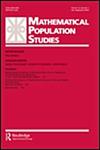用常微分方程建立糖尿病人群模型的研究进展
IF 1.3
3区 社会学
Q3 DEMOGRAPHY
引用次数: 5
摘要
综述了应用常微分方程的糖尿病群体模型。它们是通过结合非糖尿病患者、糖尿病前期患者、低认知糖尿病前期患者和认知计划来完善的。然而,它们可能涉及的产品和组分不能反映对现实的了解,或者忽略了糖尿病发展中存在的时间滞后。没有一个模型考虑到所考虑的有限医疗。这篇综述表明,在糖尿病流行病学建模中,需要考虑更精细的相互作用、时间延迟和预算限制规范。本文章由计算机程序翻译,如有差异,请以英文原文为准。
Population models of diabetes mellitus by ordinary differential equations: a review
ABSTRACT Population models of diabetes using ordinary differential equations are reviewed. They are refined by incorporating non-diabetics, prediabetics, low awareness prediabetics, awareness prediabetics, and awareness programs. However, they may involve products and fractions that do not reflect what is known about reality or ignore the presence of time lags in the development of diabetes. No model takes into account the limited medical treatments considered. This review shows the need to consider finer specifications of interactions, time delays, and budget constraints in epidemiological modeling of diabetes.
求助全文
通过发布文献求助,成功后即可免费获取论文全文。
去求助
来源期刊

Mathematical Population Studies
数学-数学跨学科应用
CiteScore
3.20
自引率
11.10%
发文量
7
审稿时长
>12 weeks
期刊介绍:
Mathematical Population Studies publishes carefully selected research papers in the mathematical and statistical study of populations. The journal is strongly interdisciplinary and invites contributions by mathematicians, demographers, (bio)statisticians, sociologists, economists, biologists, epidemiologists, actuaries, geographers, and others who are interested in the mathematical formulation of population-related questions.
The scope covers both theoretical and empirical work. Manuscripts should be sent to Manuscript central for review. The editor-in-chief has final say on the suitability for publication.
 求助内容:
求助内容: 应助结果提醒方式:
应助结果提醒方式:


